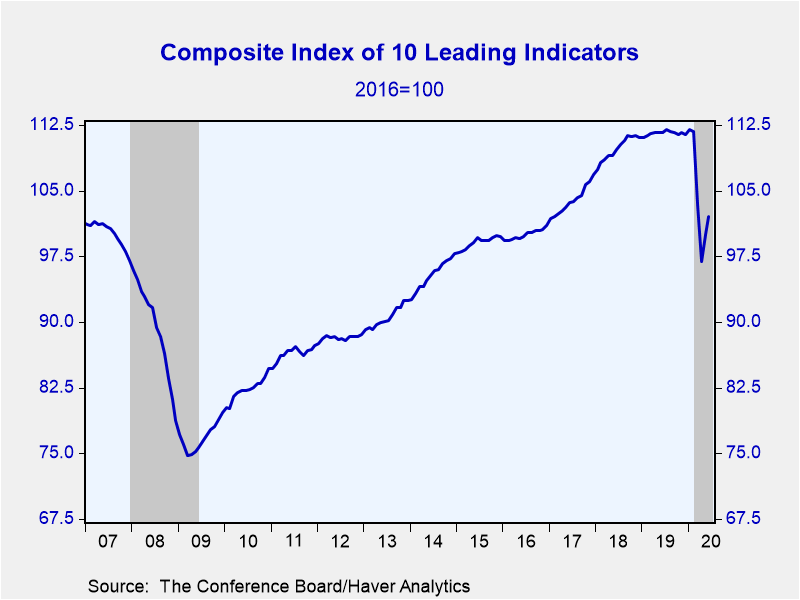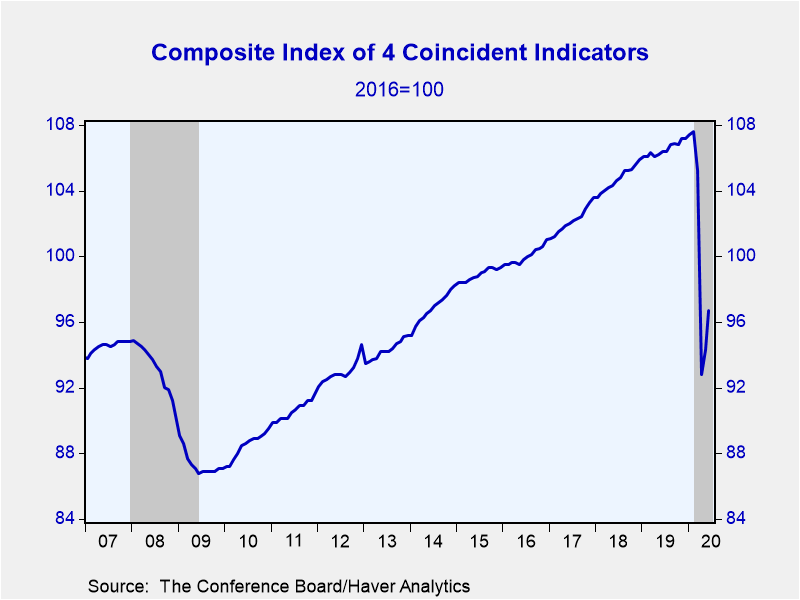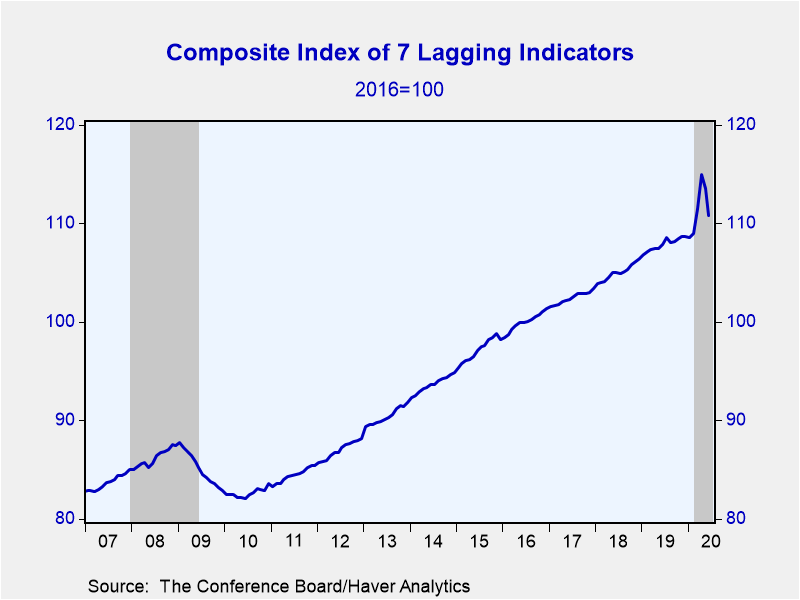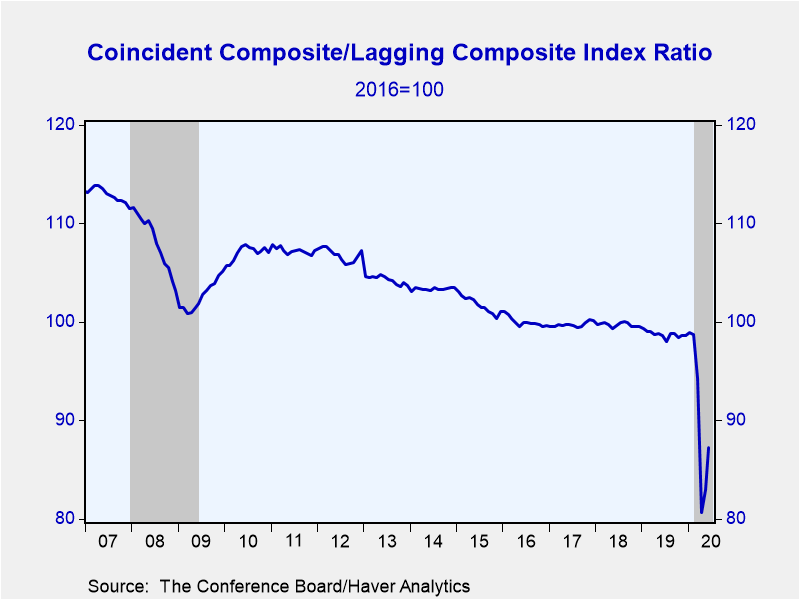 Global| Jul 23 2020
Global| Jul 23 2020U.S. Leading Indicators Post Second Strong Increase in June
by:Tom Moeller
|in:Economy in Brief
Summary
• Component gains again are broad-based. • Coincident indicators improve as well. • Lagging indicators continue to indicate less economic stress. The Conference Board reported that its Composite Index of Leading Economic Indicators [...]
• Component gains again are broad-based.
• Coincident indicators improve as well.
• Lagging indicators continue to indicate less economic stress.
The Conference Board reported that its Composite Index of Leading Economic Indicators increased 2.0% during June (-8.6% y/y) following a 3.2% May rise, revised from 2.8%. A 2.1% gain had been expected in the Action Economics Forecast Survey. The series is comprised of 10 components which tend to precede changes in overall economic activity.
Last month's gain in the leading index again reflected widespread improvement amongst the component series. Seven of the ten components rose, as they did in May. The largest positive contributions came from fewer initial unemployment insurance claims which accounted for 1.4 percentage points of the total's increase. A longer factory sector workweek added 0.4 point. Higher stock prices added 0.2 percentage point to the gain. More building permits added 0.1 point to the total's rise as did the interest rate spread between 10-year Treasury notes and Fed funds. These gains were offset by minimal declines in other component series, including consumer expectations for business/economic conditions, consumer goods orders and the leading credit index.
Three-month growth in the leading index of -5.3% (AR) in June compared to a record decline of 44.0% in April.
The Index of Coincident Economic Indicators increased 2.5% in June (-9.1% y/y) following a 1.6% May rise, revised from 1.1%. A gain in payroll employment added 1.9 percentage points to the index rise. Industrial production also rose and added 0.8 percentage points. Personal income less transfer payments added minimally to the total's increase, and manufacturing & trade sales fell.
Three-month growth in the coincident index of -28.6% (AR) ending in June followed two straight months of decline over 40%.
The Index of Lagging Economic Indicators fell 2.5% (+2.7% y/y) in June after declining 1.2% in May, revised from -1.9%. Contributing negatively to the index change was the average duration of unemployment which subtracted 1.7 percentage points. Commercial & industrial loans outstanding subtracted 0.6 percentage points while the consumer installment credit/personal income ratio sapped 0.5 percentage point. The business inventory/sales ratio added slightly to the index change as did six-month growth in the services CPI.
Three-month growth in the lagging index in June dropped to -2.5% (AR) from 18.0% in May.
The ratio of coincident-to-lagging economic indicators is considered another leading indicator of economic activity. It rose sharply for a second month from its near-record low.
The Conference Board figures are available in Haver's BCI database; the components are available there, and most are also in USECON. The expectations are in the AS1REPNA database. Visit the Conference Board's site for coverage of leading indicator series from around the world.
| Business Cycle Indicators (%) | Jun | May | Apr | Jun Y/Y | 2019 | 2018 | 2017 |
|---|---|---|---|---|---|---|---|
| Leading | 2.0 | 3.2 | -6.3 | -8.6 | 1.6 | 5.7 | 3.9 |
| Coincident | 2.5 | 1.6 | -11.8 | -9.1 | 1.8 | 2.5 | 2.2 |
| Lagging | -2.5 | -1.2 | 3.1 | 2.7 | 2.8 | 2.5 | 2.4 |
Tom Moeller
AuthorMore in Author Profile »Prior to joining Haver Analytics in 2000, Mr. Moeller worked as the Economist at Chancellor Capital Management from 1985 to 1999. There, he developed comprehensive economic forecasts and interpreted economic data for equity and fixed income portfolio managers. Also at Chancellor, Mr. Moeller worked as an equity analyst and was responsible for researching and rating companies in the economically sensitive automobile and housing industries for investment in Chancellor’s equity portfolio. Prior to joining Chancellor, Mr. Moeller was an Economist at Citibank from 1979 to 1984. He also analyzed pricing behavior in the metals industry for the Council on Wage and Price Stability in Washington, D.C. In 1999, Mr. Moeller received the award for most accurate forecast from the Forecasters' Club of New York. From 1990 to 1992 he was President of the New York Association for Business Economists. Mr. Moeller earned an M.B.A. in Finance from Fordham University, where he graduated in 1987. He holds a Bachelor of Arts in Economics from George Washington University.










